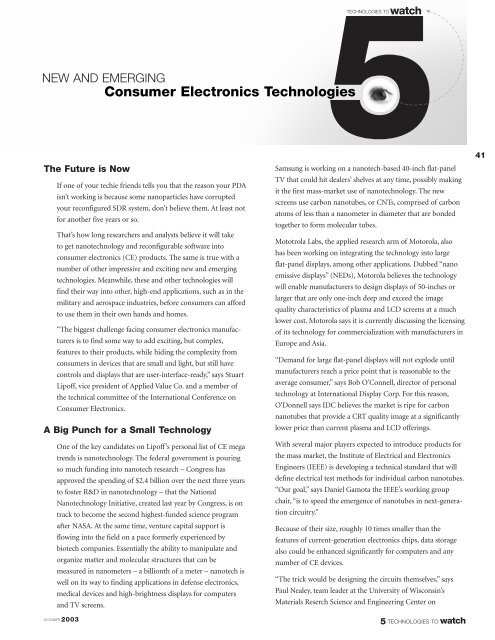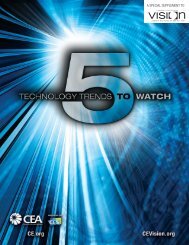TECHNOLOGIES TO watch - Consumer Electronics Association
TECHNOLOGIES TO watch - Consumer Electronics Association
TECHNOLOGIES TO watch - Consumer Electronics Association
You also want an ePaper? Increase the reach of your titles
YUMPU automatically turns print PDFs into web optimized ePapers that Google loves.
<strong>TECHNOLOGIES</strong> <strong>TO</strong><strong>watch</strong>NEW AND EMERGING<strong>Consumer</strong> <strong>Electronics</strong> TechnologiesThe Future is NowIf one of your techie friends tells you that the reason your PDAisn’t working is because some nanoparticles have corruptedyour reconfigured SDR system, don’t believe them. At least notfor another five years or so.That’s how long researchers and analysts believe it will taketo get nanotechnology and reconfigurable software intoconsumer electronics (CE) products. The same is true with anumber of other impressive and exciting new and emergingtechnologies. Meanwhile, these and other technologies willfind their way into other, high-end applications, such as in themilitary and aerospace industries, before consumers can affordto use them in their own hands and homes.“The biggest challenge facing consumer electronics manufacturersis to find some way to add exciting, but complex,features to their products, while hiding the complexity fromconsumers in devices that are small and light, but still havecontrols and displays that are user-interface-ready,” says StuartLipoff, vice president of Applied Value Co. and a member ofthe technical committee of the International Conference on<strong>Consumer</strong> <strong>Electronics</strong>.A Big Punch for a Small TechnologyOne of the key candidates on Lipoff’s personal list of CE megatrends is nanotechnology. The federal government is pouringso much funding into nanotech research – Congress hasapproved the spending of $2.4 billion over the next three yearsto foster R&D in nanotechnology – that the NationalNanotechnology Initiative, created last year by Congress, is ontrack to become the second highest-funded science programafter NASA. At the same time, venture capital support isflowing into the field on a pace formerly experienced bybiotech companies. Essentially the ability to manipulate andorganize matter and molecular structures that can bemeasured in nanometers – a billionth of a meter – nanotech iswell on its way to finding applications in defense electronics,medical devices and high-brightness displays for computersand TV screens.OC<strong>TO</strong>BER 2003Samsung is working on a nanotech-based 40-inch flat-panelTV that could hit dealers’ shelves at any time, possibly makingit the first mass-market use of nanotechnology. The newscreens use carbon nanotubes, or CNTs, comprised of carbonatoms of less than a nanometer in diameter that are bondedtogether to form molecular tubes.Mototrola Labs, the applied research arm of Motorola, alsohas been working on integrating the technology into largeflat-panel displays, among other applications. Dubbed “nanoemissive displays” (NEDs), Motorola believes the technologywill enable manufacturers to design displays of 50-inches orlarger that are only one-inch deep and exceed the imagequality characteristics of plasma and LCD screens at a muchlower cost. Motorola says it is currently discussing the licensingof its technology for commercialization with manufacturers inEurope and Asia.“Demand for large flat-panel displays will not explode untilmanufacturers reach a price point that is reasonable to theaverage consumer,” says Bob O’Connell, director of personaltechnology at International Display Corp. For this reason,O’Donnell says IDC believes the market is ripe for carbonnanotubes that provide a CRT quality image at a significantlylower price than current plasma and LCD offerings.With several major players expected to introduce products forthe mass market, the Institute of Electrical and <strong>Electronics</strong>Engineers (IEEE) is developing a technical standard that willdefine electrical test methods for individual carbon nanotubes.“Our goal,” says Daniel Gamota the IEEE’s working groupchair, “is to speed the emergence of nanotubes in next-generationcircuitry.”Because of their size, roughly 10 times smaller than thefeatures of current-generation electronics chips, data storagealso could be enhanced significantly for computers and anynumber of CE devices.“The trick would be designing the circuits themselves,” saysPaul Nealey, team leader at the University of Wisconsin’sMaterials Reserch Science and Engineering Center on5 <strong>TECHNOLOGIES</strong> <strong>TO</strong> <strong>watch</strong>41










